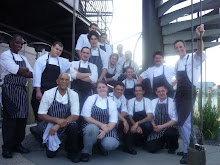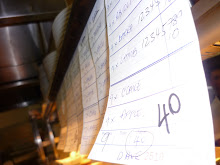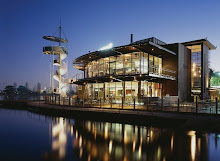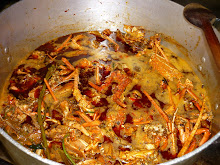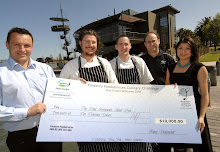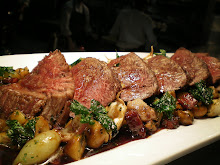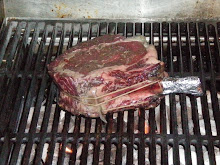Well spring is finally here! The days are getting a little longer, the nights not so cold, and all the beautiful flowers and blossoms are starting to appear in the fields.
The best thing about spring is the fact that after a long cold winter, you can dramatically see the changes in the flavours and colors. Spring lamb are here, citrus is in full swing, artichokes are back, and one of my favourite products, asparagus (both white and green) has just appeared. Spring also means local morels...great!
These new flavours are really brought to life with the use of softer techniques. Our venison is now poached rather than roasted, the fish is confit and grilled, and the king prawns are cooked in an escabehce. All fresh and vibrant - just what spring is all about!
With the change of season comes a change of menu... Each spring I try to design a dish around the new season's milk fed baby lamb and this year is no exception! There is just something special about the animal itself, and the joy of working with a comlete beast (or baby…..). Braising the shoulder, confit the belly, slow cooking the neck, roasting the leg and saute the saddle, is just something I love to do!
The accompaniments changes depending on what is in, but normally simple ingredients like broad beans, peas, organic single clove garlic and, of course, asparagus!
It’s a fantastic time of year, one full of colors and new aroma's, shapes and sizes, and things I haven’t seen, well, for almost a year…
Thursday, September 24, 2009
Wednesday, June 10, 2009
Roast Rib-eye with winter root vegetables, Yorkshire pudding and horseradish cream
Roast Rib-eye with winter root vegetables, Yorkshire pudding and horseradish cream
Ingredients:
1.5kg rib-eye (allow approx. 400g per person)
Handful of rosemary and fresh thyme
2 garlic cloves
Winter root vegetables (swede, pumpkin, turnip, parsnip, potatoes), chopped
Salt, pepper, olive oil
Horseradish cream (whisk together 1 tablespoon thickened cream, 1 teaspoon horseradish, pinch of salt and pepper)
Yorkshire pudding:
1 cup of flour
1 cup of eggs
½ cup milk
½ cup water
* Serves 4
Method:
Preheat oven to 140˚C. Season beef with salt and pepper; heat 1 tablespoon of oil in large frypan and add beef when pan is very hot. Seal beef on each side, remove from frypan and place in oven. Slow roast for 45 mins or until internal temperature is at 42˚C. To test without using a thermometer, pierce meat with a metal skewer until at the centre. Remove and press skewer to skin (upper lip is best as it is most sensitive). Beef is ready when skewer temperature is comfortably warm on the skin. When ready remove beef from oven, cover with foil and rest for about half the time it was cooked for – in this case, about 20 minutes.
Increase oven to 200˚C. Warm some oil in a frypan, add root vegetables and toss through oil until coloured. Transfer to a shallow baking dish, add a handful of thyme and rosemary, whole garlic cloves, salt, pepper and a coating of olive oil. Place in oven.
Roast vegetables for 20 mins, or until browned. Five minutes before serving, place beef back in oven for another five minutes. Vegetables and beef will then be ready to serve together.
Yorkshire pudding:
Heat oven to 220˚C.. Half fill each cup of a muffin tin with beef dripping (or lard) and place in hot oven. Whisk wet ingredients together then pour slowly into flour, stirring constantly. Add a pinch of salt and pepper, hand whisk until mixture resembles a batter, with soft, firm peaks. When dripping/lard is bubbling in muffin tins, remove from oven and carefully ladle in batter until full. Bake on 220˚C. for 20 minutes then continue at 150˚C. for 10 minutes.
To serve:
Carve beef and arrange on plate with a bed of roast vegetables, one Yorkshire pudding and a dollop of horseradish cream.
Ingredients:
1.5kg rib-eye (allow approx. 400g per person)
Handful of rosemary and fresh thyme
2 garlic cloves
Winter root vegetables (swede, pumpkin, turnip, parsnip, potatoes), chopped
Salt, pepper, olive oil
Horseradish cream (whisk together 1 tablespoon thickened cream, 1 teaspoon horseradish, pinch of salt and pepper)
Yorkshire pudding:
1 cup of flour
1 cup of eggs
½ cup milk
½ cup water
* Serves 4
Method:
Preheat oven to 140˚C. Season beef with salt and pepper; heat 1 tablespoon of oil in large frypan and add beef when pan is very hot. Seal beef on each side, remove from frypan and place in oven. Slow roast for 45 mins or until internal temperature is at 42˚C. To test without using a thermometer, pierce meat with a metal skewer until at the centre. Remove and press skewer to skin (upper lip is best as it is most sensitive). Beef is ready when skewer temperature is comfortably warm on the skin. When ready remove beef from oven, cover with foil and rest for about half the time it was cooked for – in this case, about 20 minutes.
Increase oven to 200˚C. Warm some oil in a frypan, add root vegetables and toss through oil until coloured. Transfer to a shallow baking dish, add a handful of thyme and rosemary, whole garlic cloves, salt, pepper and a coating of olive oil. Place in oven.
Roast vegetables for 20 mins, or until browned. Five minutes before serving, place beef back in oven for another five minutes. Vegetables and beef will then be ready to serve together.
Yorkshire pudding:
Heat oven to 220˚C.. Half fill each cup of a muffin tin with beef dripping (or lard) and place in hot oven. Whisk wet ingredients together then pour slowly into flour, stirring constantly. Add a pinch of salt and pepper, hand whisk until mixture resembles a batter, with soft, firm peaks. When dripping/lard is bubbling in muffin tins, remove from oven and carefully ladle in batter until full. Bake on 220˚C. for 20 minutes then continue at 150˚C. for 10 minutes.
To serve:
Carve beef and arrange on plate with a bed of roast vegetables, one Yorkshire pudding and a dollop of horseradish cream.
Roast rack of pork with braised cabbage and caramelised apples
Given that we've well and truly plunged into winter in Melbourne, I thought it was time to share an all time favourite roast dish...definitely one to warm the soul during winter I reckon!
Roast rack of pork with braised cabbage and caramelised apples
Ingredients:
1 eight-point pork rack (2.5kg – with bone on; 1 point per person)
½ savoy cabbage (finely shredded with veins removed)
1 x carrot; stick of celery; white onion
½ celeriac
1 white onion
2 cloves garlic
100g pancetta
Herbs: 1 bay leaf, 1 sprig sage and thyme
8 granny smith apples
1 cup x white wine vinegar; olive oil
Sea salt and pepper
100g butter
100g caster sugar
100ml dry white wine
* Serves 8
Method:
Pork: Score pork skin to criss-cross pattern, rub with vinegar and leave in fridge overnight to dry. Pre-heat oven to 230˚C. Remove pork from fridge, rub with olive oil and salt then place in hot oven. After 15 mins, reduce oven to 160˚C and cook for further 35 to 45 mins, or until core temperature is 42˚C. Remove from oven, cover with foil and rest for 20 mins.
Braised cabbage: Whilst pork is cooking, dice all vegetables and pancetta. Warm 1 tablespoon of duck fat (or olive oil) in a heavy-bottomed saucepan, then add diced vegetables, shredded cabbage, crushed garlic, pancetta and a pinch of sea salt. Sweat vegetables for 5 – 10 mins or until the vegetables soften. Add white wine and herbs. Cook with lid on for 35 mins.
Caramelised apples: peel apples, cut into quarters and remove core. Melt butter in fry pan, add apples quarters and cover with caster sugar. Toss in pan to ensure apples are covered with caramel sauce and simmer for 15 – 20 mins, or until apples start to soften and produce juice. If caramel gets too dark, add a splash of white wine.
To serve:
Carve pork between each point and arrange one chop per person on the plate, with a bed of braised cabbage and four apple pieces. Drizzle remaining caramel over pork.
Roast rack of pork with braised cabbage and caramelised apples
Ingredients:
1 eight-point pork rack (2.5kg – with bone on; 1 point per person)
½ savoy cabbage (finely shredded with veins removed)
1 x carrot; stick of celery; white onion
½ celeriac
1 white onion
2 cloves garlic
100g pancetta
Herbs: 1 bay leaf, 1 sprig sage and thyme
8 granny smith apples
1 cup x white wine vinegar; olive oil
Sea salt and pepper
100g butter
100g caster sugar
100ml dry white wine
* Serves 8
Method:
Pork: Score pork skin to criss-cross pattern, rub with vinegar and leave in fridge overnight to dry. Pre-heat oven to 230˚C. Remove pork from fridge, rub with olive oil and salt then place in hot oven. After 15 mins, reduce oven to 160˚C and cook for further 35 to 45 mins, or until core temperature is 42˚C. Remove from oven, cover with foil and rest for 20 mins.
Braised cabbage: Whilst pork is cooking, dice all vegetables and pancetta. Warm 1 tablespoon of duck fat (or olive oil) in a heavy-bottomed saucepan, then add diced vegetables, shredded cabbage, crushed garlic, pancetta and a pinch of sea salt. Sweat vegetables for 5 – 10 mins or until the vegetables soften. Add white wine and herbs. Cook with lid on for 35 mins.
Caramelised apples: peel apples, cut into quarters and remove core. Melt butter in fry pan, add apples quarters and cover with caster sugar. Toss in pan to ensure apples are covered with caramel sauce and simmer for 15 – 20 mins, or until apples start to soften and produce juice. If caramel gets too dark, add a splash of white wine.
To serve:
Carve pork between each point and arrange one chop per person on the plate, with a bed of braised cabbage and four apple pieces. Drizzle remaining caramel over pork.
Monday, April 20, 2009
Reflections on the Festival
Sorry its been a while since my last post, but now that things have finally quietened down a little after The Melbourne Food & Wine Festival, Australian Grand Prix and Easter are over - it gives me time to reflect about the past few months.....and share some of my thoughts....
The highlight for me was without a doubt the visit from my former boss Philip Howard. For the six days we had Phil ( and his current sous chef Mark Kempson, a lovely geezer)in the kitchen here it was a bit "like old times" for me. I felt like a Sous again - learning new tricks from the master and being let into the head space of someone I consider to be a genius.
For me, the biggest win during Phil's visit was the refreshed inspiration it gave me. I learnt to reconsider that sometimes it's the simple and clean flavor combinations that are best. To also have another look at ingredients like the fabulous brillat savarin that now makes an appearance as a cheesecake on our dessert menu, or to appreciate the wonders of a game consomme again. Who would have thought I'd learn that deep down, some of the best years of my cooking life (certainly the hardest and most intense) had been my time in london working with phil. it made me reminisce about the past, and to truly marvel at a remarkable man, a true gentleman, and one of the worlds finest chefs. Not just from a food point of view, but someone who values life, people, and is considerate and generous in an industry that is full of rogues and misfits!
Having Phil here was also a real bonus for our staff, across the board. The kitchen was a different place whilst Phil was present - the boys certainly picked up their acts and I'm happy to say this hasn't dropped!
Overall, having Phil in our kitchen was an amazing experience for everyone involved and something which I'm sure will have a long-lasting effect.
The highlight for me was without a doubt the visit from my former boss Philip Howard. For the six days we had Phil ( and his current sous chef Mark Kempson, a lovely geezer)in the kitchen here it was a bit "like old times" for me. I felt like a Sous again - learning new tricks from the master and being let into the head space of someone I consider to be a genius.
For me, the biggest win during Phil's visit was the refreshed inspiration it gave me. I learnt to reconsider that sometimes it's the simple and clean flavor combinations that are best. To also have another look at ingredients like the fabulous brillat savarin that now makes an appearance as a cheesecake on our dessert menu, or to appreciate the wonders of a game consomme again. Who would have thought I'd learn that deep down, some of the best years of my cooking life (certainly the hardest and most intense) had been my time in london working with phil. it made me reminisce about the past, and to truly marvel at a remarkable man, a true gentleman, and one of the worlds finest chefs. Not just from a food point of view, but someone who values life, people, and is considerate and generous in an industry that is full of rogues and misfits!
Having Phil here was also a real bonus for our staff, across the board. The kitchen was a different place whilst Phil was present - the boys certainly picked up their acts and I'm happy to say this hasn't dropped!
Overall, having Phil in our kitchen was an amazing experience for everyone involved and something which I'm sure will have a long-lasting effect.
Monday, March 2, 2009
The Festival Dawns
For anyone involved in the wonderful world of food and wine in Melbourne, March is often manic as The Melbourne Food and Wine Festival descends on the city...much to the delight of foodies and imbibers, such as myself, across the state.
The Festival brings with it a host of international chefs - including my mate and mentor Phil Howard - and many other chefs that I hope to catch up with or maybe just catch a glimpse of! Having so many world renowned chefs in my home town is not only rare, but also inspiring.
For more than a week we'll have Phil Howard and his Junior Sous Chef Mark Kempson cooking in our kitchen, which is such a great opportunity to show our team what it means to work at a two star Michelin level. A few of the boys in the kitchen have worked overseas, but for those who haven't, it'll be like working in one of London's best kitchens, alongside one of the country's best chefs. That's the standard I've come from and one I want my team to understand.
I suppose the major difference between Australian and European kitchens would probably be the "intensity" that exists in most great kitchen's you step into. The brigade seems to be more focused, a little bit more dedicated and normally work a lot more hours than we do here!
I'd say that overseas most of the guys are exposed to more early on and have opportunities that unfortunately just don't exist in Oz. That's why it's so important for us to bring international chefs out here and support Australia's next generation of chefs...
The Festival also gives us a chance to get the best out of our events team. This year, we're hosting a range of events: a seven-course degustation gala dinner (The Point Gets Squared); a NZ vs. OZ wine match (The Bledisloe) and a lakeside family BBQ (The Family Fair Day). That means we have to organise everything - from premium international wines and West Australian marron to a Maori hakka team, face painters and jumping castles. We're really putting their organisation skills to the test this month, but I've got complete confidence we'll pull it off without a hitch!
We are also hosting a special chef's industry dinner, cooked by Phil and ex-square boys that are now living and working in Melbourne, so a pretty special event also...we don't really have the time to all catch up these days very often, so it should be lots of fun, great banter and probably a few quiet beers enjoyed afterwards!
For me and the team, March also means Grand Prix. This curious mix of food, wine and fast cars (three of my favourite things) often leaves us satisfied and exhausted, carrying a few more kilos and a hearing a little less, but also saying "bring on April"...
The Festival brings with it a host of international chefs - including my mate and mentor Phil Howard - and many other chefs that I hope to catch up with or maybe just catch a glimpse of! Having so many world renowned chefs in my home town is not only rare, but also inspiring.
For more than a week we'll have Phil Howard and his Junior Sous Chef Mark Kempson cooking in our kitchen, which is such a great opportunity to show our team what it means to work at a two star Michelin level. A few of the boys in the kitchen have worked overseas, but for those who haven't, it'll be like working in one of London's best kitchens, alongside one of the country's best chefs. That's the standard I've come from and one I want my team to understand.
I suppose the major difference between Australian and European kitchens would probably be the "intensity" that exists in most great kitchen's you step into. The brigade seems to be more focused, a little bit more dedicated and normally work a lot more hours than we do here!
I'd say that overseas most of the guys are exposed to more early on and have opportunities that unfortunately just don't exist in Oz. That's why it's so important for us to bring international chefs out here and support Australia's next generation of chefs...
The Festival also gives us a chance to get the best out of our events team. This year, we're hosting a range of events: a seven-course degustation gala dinner (The Point Gets Squared); a NZ vs. OZ wine match (The Bledisloe) and a lakeside family BBQ (The Family Fair Day). That means we have to organise everything - from premium international wines and West Australian marron to a Maori hakka team, face painters and jumping castles. We're really putting their organisation skills to the test this month, but I've got complete confidence we'll pull it off without a hitch!
We are also hosting a special chef's industry dinner, cooked by Phil and ex-square boys that are now living and working in Melbourne, so a pretty special event also...we don't really have the time to all catch up these days very often, so it should be lots of fun, great banter and probably a few quiet beers enjoyed afterwards!
For me and the team, March also means Grand Prix. This curious mix of food, wine and fast cars (three of my favourite things) often leaves us satisfied and exhausted, carrying a few more kilos and a hearing a little less, but also saying "bring on April"...
Wednesday, January 21, 2009
Phil Howard - my mentor and my mate - comes to Melbourne
A few years ago I was lucky enough to work at The Square, a two star michelin restaurant in Mayfair, London, under Chef and co-owner Philip Howard.
Having worked shoulder to shoulder with Phil for over three years, I developed a strong friendship that's based on a mutual love of food and a similar approach to cooking. I have a deep respect for the man who taught me not just new techniques and flavour combinations, but a whole new food philosophy.
Last year, Phil agreed to visit us at The Point during Melbourne Food and Wine Festival in March. It's only a few weeks til he gets here - he arrives on the 17th March - so we're 'all systems go' at the moment, preparing for the arrival of my mentor and mate.
We'll be pretty flat out during his visit too - a fair few people are keen to meet the man, and have him cook for them!We have a couple of special dinners planned,and we'll also be running a Square inspired menu in the dining room that week, but i'll talk more about that closer to the date. I just hope he's not expecting a holiday...
Having worked shoulder to shoulder with Phil for over three years, I developed a strong friendship that's based on a mutual love of food and a similar approach to cooking. I have a deep respect for the man who taught me not just new techniques and flavour combinations, but a whole new food philosophy.
Last year, Phil agreed to visit us at The Point during Melbourne Food and Wine Festival in March. It's only a few weeks til he gets here - he arrives on the 17th March - so we're 'all systems go' at the moment, preparing for the arrival of my mentor and mate.
We'll be pretty flat out during his visit too - a fair few people are keen to meet the man, and have him cook for them!We have a couple of special dinners planned,and we'll also be running a Square inspired menu in the dining room that week, but i'll talk more about that closer to the date. I just hope he's not expecting a holiday...
Wednesday, December 17, 2008
Summer Pudding with Mascarpone
A Christmas-time classic, this recipe is incredibly simple and presents beautifully. The vibrant, fresh summer berries make it the perfect way to round off any Christmas feast.
Ingredients: serves 4
1 loaf white sliced bread
1 punnet each of summer berries: could include raspberries, red or white currants, blueberries, mulberries, blackberries, strawberries or logan berries.
250g good mascarpone
Mint tips
500ml mixed berry coulis: Blend leftover or frozen mixed berries (3 cups) with equal parts water and sugar, adjust consistency and flavour by adding more/less of each ingredient or a squeeze of lemon.
Equipment:
4 x soufflé moulds / deep ramekins
1 x large tray
Method:
Step 1: Preparation
Cut 24 slices of bread to the size of your soufflé mould or ramekin and place on a large tray. Cover with three quarters of the berry coulis, or until it absorbs most of the sauce and changes to a deep red.
Step 2: Assembly
Line souffle mould with cling film and place a disc of bread on the base. Place a few mixed berries on top and drizzle with coulis from bread tray. Repeat this layering until the souffle mould is full, finishing with a layer of bread.
Cover each mould with cling film and place a light weight on top of puddings to compress. Refrigerate overnight.
To serve:
Remove the puddings from the mould by turning upside down. Garnish with mixed berries, a dollop of mascarpone, remaining berry coulis and couple of mint leaves.
Ingredients: serves 4
1 loaf white sliced bread
1 punnet each of summer berries: could include raspberries, red or white currants, blueberries, mulberries, blackberries, strawberries or logan berries.
250g good mascarpone
Mint tips
500ml mixed berry coulis: Blend leftover or frozen mixed berries (3 cups) with equal parts water and sugar, adjust consistency and flavour by adding more/less of each ingredient or a squeeze of lemon.
Equipment:
4 x soufflé moulds / deep ramekins
1 x large tray
Method:
Step 1: Preparation
Cut 24 slices of bread to the size of your soufflé mould or ramekin and place on a large tray. Cover with three quarters of the berry coulis, or until it absorbs most of the sauce and changes to a deep red.
Step 2: Assembly
Line souffle mould with cling film and place a disc of bread on the base. Place a few mixed berries on top and drizzle with coulis from bread tray. Repeat this layering until the souffle mould is full, finishing with a layer of bread.
Cover each mould with cling film and place a light weight on top of puddings to compress. Refrigerate overnight.
To serve:
Remove the puddings from the mould by turning upside down. Garnish with mixed berries, a dollop of mascarpone, remaining berry coulis and couple of mint leaves.
Labels:
berry,
christmas desert,
coulis,
summer berries,
Summer pudding
Subscribe to:
Comments (Atom)


